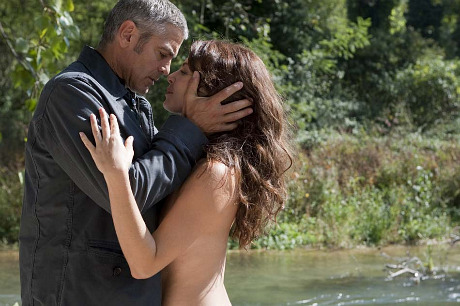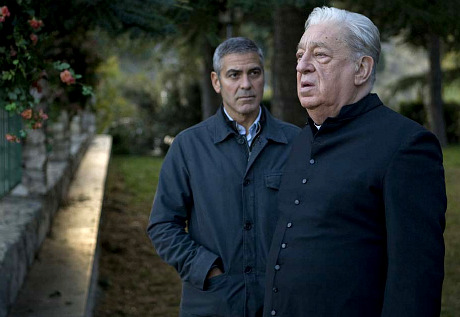Anton Corbijn‘s The American (Focus Features, 9.1) is a moderately soothing art piece and an excellent Machete antidote. After you’ve had your blood sausage and micro-waved tacos, The American will feel like a drink of cool mountain water. It’s certainly a tasteful walk (wank?) in the woods. You’ll feel unsullied when it’s over, and gratified that Corbijn and Focus Features respect you, and are not treating you the way Robert Rodriguez treats his fans. This is the other side of the mountain.

Georeg Clooney, Violante Placido in Anton Corbijn’s The American.
And yet there’s something about The American — a lot actually — that feels tastefully repressed and mummified. It’s vaguely Antonioni-ish but at the same time not really because it isn’t “about” any social zeitgiest thing. But it’s certainly aromatic and scenic. Martin Ruhe‘s photography is exquisite here and there.
The American is stirring, in short, for what it doesn’t do and for the meditative tone and cappucino atmosphere. But if the idea was to make some kind of thriller then forget it, folks. It’s a quietly unsettling thing from time to time, but it’s about eerie “uh-oh” feelings rather than pulse-quickenings. Which I was mildly okay with except for the ending, which is on another level entirely.
It’s about an assassin (George Clooney) hiding out in an Italian village and doing relatively little except making a rifle and rolling around with a local prostitute. But if female nudity does anything for you, and if you can let the thriller idea go and just roll with the easy glide of it all, it isn’t half bad and the finale — the last 20 minutes or so — is more than worth the price.
The American is mainly a piece about paranoia. About a man unable to live because he’s forced to use all his wits in order to not get killed. Living in a cave, a prison. Cautious, stealthy. And always haunted by the same thought — who and where are the predators? They’re definitely out there.
Jack (Clooney) is a professional killer who’s being hunted by certain parties, some of them clearly Swedish. His boss (Johan Leysen) suggests a job in an Italian hill town that involves constructing a special high-powered rifle for a female client (Thekla Reuten). While doing the work he strikes up a passing acquaintance with a local priest (Paolo Bonacelli) and an exceptionally good-looking prostitute (Violante Placido).

Speaking of which The American provides some gratuitous nudity that I would call wonderful, excellent, and good for the soul. I am calling it that, in fact. And it has a very nice red-lighted sex scene. Good for George and Anton during filming, and good for guys everywhere.
Corbijn is a celebrated photographer, and is known primarily for Ruhe’s exquisite lensing on Control, his debut film. But I have to say I wasn’t floored by some of the American compositions. Corbijn and Ruhe depend on a great number of close-ups and medium close-ups. There’s an early meeting in Rome between Clooney and Leysen that is all closeups and medium closeups, and I was frankly feeling bored fairly quickly. I regret saying that The American is not Control in color. I was hoping for some kind of Paul Cameron or Dion Beebe-level thing, but nope.
I wanted Bonacelli’s priest, whom I disliked immediately from the very first instant, to be killed. Every time he lumbered along with that hoarse voice and that wavy white hair and those facial jowls I went, “Oh, God…him again.” He’s way too fat and friendly and nosy. And he speaks perfect English, which seemed ridiculous for a priest from the Italian hill country. He’s the kind of Italian who sometimes turns up in American-shot movies set in Italy. A friendly guide, interpreter, counselor.
MILD SPOILERS FOLLOW:
There’s a moment at the very end when Clooney’s grim, somber-to-a-fault performance — monotonous and guarded to the point of nothingness, shut and bolted down — suddenly opens up. It’s when he asks the local prostitute to leave with him. For the first time in the film, he smiles. He relaxes and basks in the glow of feeling.
There’s a little patch of woods by a river that Clooney visits three times. Once to test his rifle, once for a picnic and a swim in the river, and then in the final scene. One too many, perhaps. But his final drive to this spot is almost — almost, I say — on the level of Jean Servais‘ final drive back into Paris in Rififi. For the second and final time in the film Clooney shows something other than steel and grimness.
The American is worth seeing for this scene alone, and for the final shot when a butterfly flutters off and the camera pans up.

The American director Anton Corbijn (l.) , George Clooney (r.)
There’s gunplay in The American, but it’s so abbreviated it’s almost on a “what?” level at times. Corbijn knows how to capture beautiful images but he doesn’t know much about shooting action, and apparently couldn’t care less.
There’s a scene in which a predator has the drop on Clooney and is right behind him, gun drawn and (as I recall) about to be pointed, and Clooney “senses” his presence and turns around and drills him. It’s that easy? There’s also a shootout in the snow — in a remote forest in Sweden — in the beginning. There’s a rifleman wearing snow gear on the ledge above, and Clooney is down below with his handgun…and suddenly he just shoots and drops the guy. Just like that?
Later on there’s another action sequence in which another Swede tries to kill him in the Italian village. Clooney is the victor again (if he wasn’t the movie would stop dead so I don’t consider this a spoiler) but he leaves the guy sitting there in a car with broken glass splattered on the road. Carabinieri and detectives would be swarming all over the next morning, and in less than an hour they’d be knocking on Clooney’s door, and they would find the hand-made rifle and the game would be over.
END OF MILD SPOILERS:
How curious, I’m thinking, that yesterday I posted a quote from former N.Y. Times critic Richard Eder that applies in a certain way to The American.
If Eder were reviewing this film today, as every critic in the country is now doing, he might say the following: “The American is handsome, meditative, elegiac and languid. It’s so coolly artful it is barely alive. First-rate ingredients and a finesse in assembling them do not quite make either a movie or a cake. At some point it is necessary to light the oven.”
By the way: I’ve never seen Richard Fleischer‘s The Last Run (1971), another movie about an elegant American criminal type (played by George C. Scott) hiding out in Europe and showing a certain facility with repairing and building things and doing the old laconic moody thing. I wonder if there are any other similarities. Anyone?









